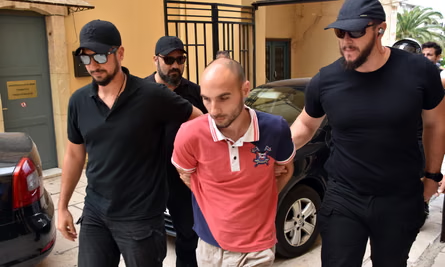Background of Giannis Lalas and His Criminal Links
Giannis Lalas emerged from a modest background in Greece, gradually carving a niche for himself within the criminal underworld. His ascent began in the late 1990s, marked by a series of strategic alliances and participation in various illicit activities that showcased his resourcefulness and tenacity. Lalas’s ability to navigate the complexities of organized crime would solidify his position among significant figures in the Greek criminal landscape.
Throughout the years, Lalas was known for his connections to several notorious gangs, which engaged in activities such as drug trafficking, extortion, and racketeering. These affiliations not only bolstered his reputation but also placed him under the scrutiny of law enforcement agencies. Individual episodes marked Lalas’s criminal trajectory, including arrests and investigations that served to highlight the pervasive influence he wielded within these circles. Notably, his entanglements did not shy away from high-profile cases, which continued to draw media attention and public speculation.
One pivotal moment in Lalas’s life was his acquittal in the murder of journalist Giorgos Karaivaz, a case that left many puzzled about his involvement. The intense scrutiny surrounding this case revealed a deeper layer of connections within the criminal ecosystem, prompting discussions about the intersecting lines of loyalty, betrayal, and retribution that characterize organized crime. Lalas’s ties—as both an alleged target of and participant in nefarious activities—exemplify the intricate relationships that often complicate legal proceedings and societal perceptions of crime. As the case unraveled, it became evident that Lalas operated within a realm where not only his life but also the broader community was significantly affected by the violent dynamics of the criminal world.
The Circumstances of Lalas’s Murder in Arachova
On the evening of November 2, 2025, the quaint town of Arachova was shaken by a violent crime that would reverberate through Greece. The victim, Giannis Lalas, a prominent figure known for his extensive work in the real estate sector, was assassinated inside his hotel room. The nature of the crime indicated a targeted attack rather than a random act of violence.
Reports indicated that the perpetrator gained entry to Lalas’s accommodations shortly after nightfall. Eyewitnesses recounted hearing a burst of gunfire that pierced the tranquil atmosphere of the hotel, drawing the attention of nearby guests. The gunman reportedly utilized an automatic weapon, suggesting a premeditated intention to cause lethal harm. The suddenness and ferocity of the attack left onlookers in shock and disbelief.
In the immediate aftermath of the shooting, local law enforcement responded promptly to the scene. They discovered Lalas unresponsive, with evident gunshot wounds. The investigation was quickly launched, as authorities worked to piece together the events leading up to the murder. Investigators soon found a burned-out vehicle in proximity to the hotel, further complicating the scenario by suggesting that it was possibly used as a getaway car by the assailant. The detectives meticulously examined the vehicle for any evidence that could shed light on the identity of the killer.
Initial findings pointed towards a potential hired killing. Law enforcement officials scrutinized Lalas’s personal and professional life, searching for connections to individuals who may have held motives for such an extreme act. As details of the crime unfolded, the community grappled with the realization that an innocent life had been taken in a brutal manner, leaving many questions surrounding the circumstances of Lalas’s murder in Arachova.
The Broader Implications of Lalas’s Death on Crime Reporting and Organized Crime
The assassination of Giannis Lalas has far-reaching implications that extend beyond the immediate circumstances of his death. As a figure intertwined with organized crime, Lalas’s murder raises critical concerns regarding crime reporting in Greece. Journalists operating in an environment where crime-related violence is prevalent often face significant challenges; they must navigate a landscape filled with intimidation and threats, which can lead to self-censorship or biased reporting. Such conditions compromise the integrity of journalism and obscure the truth concerning organized crime activities.
Lalas’s murder serves as a stark reminder of the risks that come with exposing criminal networks. Crime journalism plays a vital role in uncovering illicit activities and informing the public. However, when key figures in this arena are targeted, it creates a chilling effect on those who may wish to report on crime. This dynamic not only affects individual journalists but also the broader media landscape, which may resort to caution and limit coverage on serious crime issues. As a result, the public is deprived of critical information that could enhance awareness of safety threats linked to organized crime.
Connections to the Murder of Giorgos Karaivaz and the Underworld Feud
The assassination of Giannis Lalas has drawn parallels to the murder of Giorgos Karaivaz, a prominent Greek journalist killed in April 2021. Both incidents underscore a disturbing trend of violence directed at those who investigate and report on organized crime in Greece. Karaivaz, known for his fearless coverage of criminal activities and his revelations about corrupt practices, met a tragic fate that highlighted the perils faced by journalists who delve into the complexities of organized crime networks.
The circumstances surrounding Karaivaz’s murder were shrouded in mystery, with law enforcement authorities suggesting that it was a consequence of the ongoing feud among criminal factions. This element of score-settling is mirrored in the case of Lalas, indicating a broader narrative where journalists become unwitting targets within the violent landscape of crime and retribution. Analyzing these connections reveals how organized crime can manipulate public discourse and silence dissenting voices through intimidation, violence, and assassination.
Moreover, law enforcement officials have hinted that these killings reflect not only personal vendettas but also a calculated strategy by criminal groups to instill fear among those who dare to uncover their illicit activities. The interconnectedness of these tragedies serves as a grim reminder of the high stakes involved in crime reporting, particularly in regions where investigative journalism may be perceived as a direct threat to criminal enterprises.
In this hostile environment, the murders of Lalas and Karaivaz illustrate the precarious position of journalists, highlighting the urgent need for protective measures to safeguard those who brave the shadows of organized crime. By shedding light on the dangers faced by such individuals, society underscores the importance of free press and accountability in the fight against crime and corruption.

